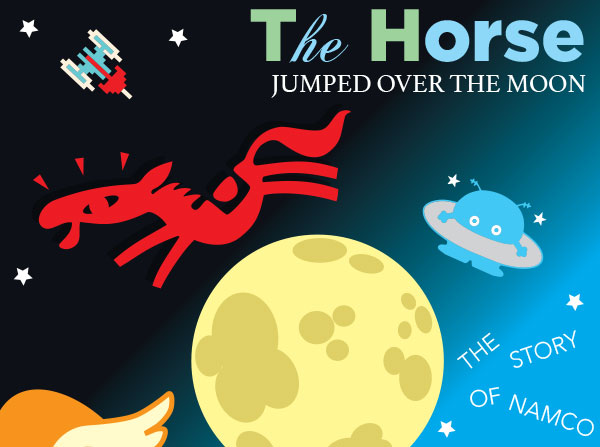
Namco had an ambitious goal. To build an urban theme park in one of the busiest cities of the world. Wonder Eggs would be located in Futakotamagawa, Setagaya Ward Tokyo. It was originally meant to be a temporary park, but ran from February 1992 to December 2000. It had a strong theme, its own origin myth, and even its own language. It did so well that a sister park named the Egg Empire was built shortly after. Sadly the second gate lacked the creative spark that went into Wonder Eggs. A majority of the attractions featured at the Egg Empire were off-the-shelf rides which could be found at other amusement parks, and even shopping malls. The opening of Wonder Eggs 3 in 1999, featured the massive 56-seater 4D attraction “Fun House Express” starring Jimmy the Clown. This attraction was produced by
Showscan Entertainment Inc. The company I talked about previously.
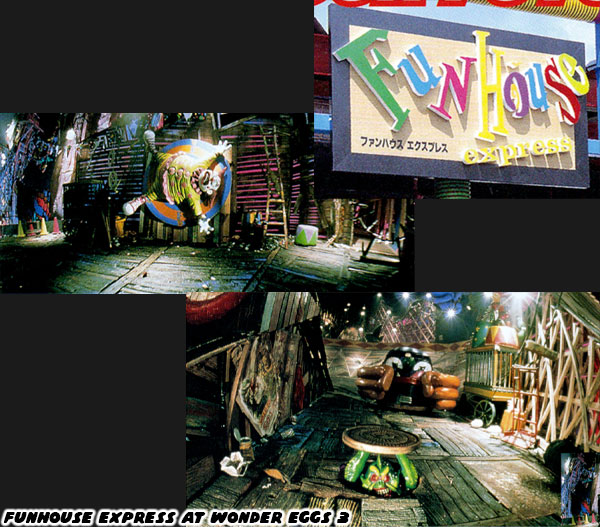
The Egg Empire was in dire need of more direction. It was struggling compared to Wonder Eggs. The Q-Zar Arena in particular, the laser tag center, seemed to be underperforming. I felt that this was the only attraction at the park where the financing people at Namco came crawling to the design team, and begged them to fix up the space. Those designers saw that the building had a huge area to work with. Plus elevators, tunnels, and ramps they could dress up. They would be able to create an entirely new experience relatively quickly. The Q-Zar Arena would be replaced with a Participatory Story Attraction, similar to
the Hotel Ghost that I described earlier. The Mummy - Hamunaptra - The Lost Desert Capital was based on the 1999 Hollywood movie “The “Mummy”, the Japanese name of the film was “Hamunaptra.”
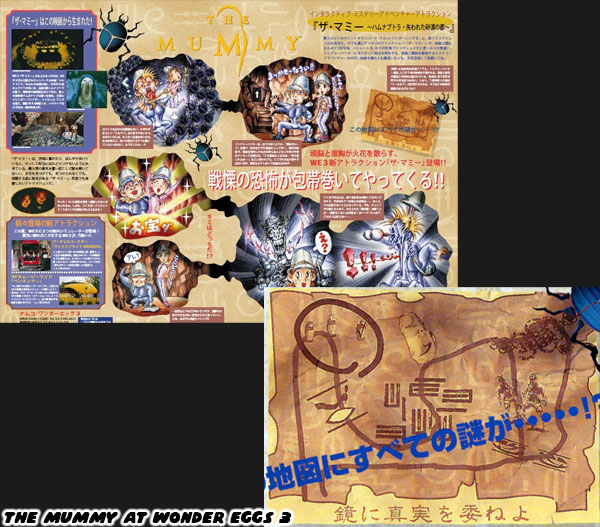
The attraction allowed eight people to play at once. The multiple-story interior of the Q-Zar arena was unrecognizable to visitors. It now looked like a series of caves, and ancient Egyptian temples. The guests would all hold onto a rope as to not get lost. They went from puzzle to puzzle looking for clues. It featured actors in costumes, animatronics, smoke, moving sets, and projection effects. It also featured original music from composer
Yuka Watanabe. She not only wrote for different game studios, but also wrote original compositions for Sega’s Joypolis. If player figured out how to access the tomb of Hamunaptra then they could pick a magnetic “Karla Card” out of the pile of “treasures.” If they solved the puzzles, and answered the question correctly at the end then the employees would reward them with a prize. It very much had all the magic of the Participatory Story Attractions across the street.

When the Egg Empire was built it was treated as a separate park. It was very close in distance, but had its own gate. It also allowed customers to pay cash at certain attractions rather than use the Karla Card magnetic ticket system. Namco did not invest as much changing, and plussing attractions at the Egg Empire as they did at Wonder Eggs. In order to bring in new visits they started adding more off-the-shelf attractions to the park. Specifically motion rides. These were created by any number of companies, and often featured a live action, or CGI film projected at the front of a motion simulator. The SFX Movie Ride - “Venturer” was added to the park circa 1999. The description from Namco was; “Experience a simulated world of powerful SFX images on a large movie ride that seats 15 people! The highlight is the two-part SFX film
Space Race and “Alien Encounter" produced by ILM led by George Lucas. Rush through the universe with powerful images!! ¥500 yen per person.” I could not find an Alien Encounter VR ride, but I did find an
Alien Ride at the Speed of Fright attraction which might have been the same thing.
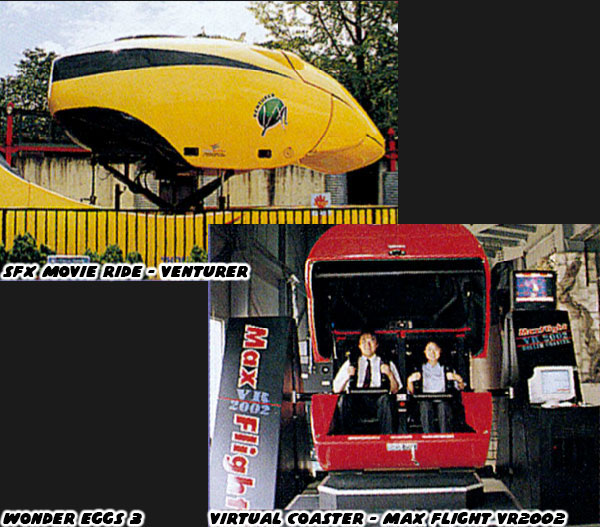
A seasonal
The Snowman the Ride ran between November - December in 1999, and 2000. The “Virtual Coaster” was also added to the park. This simulator was a much different experience. The
Max Flight VR2002 was according to Namco; “a two-person ride that takes 90 seconds to soar, drop, and turn sharply up, down, left, and right. The excitement of continuous 360° loops will hit you directly. You can select 9 courses and design more than 1 million courses. The presence of a "stop button" within the ride is proof of its intensity. ¥500 per person.
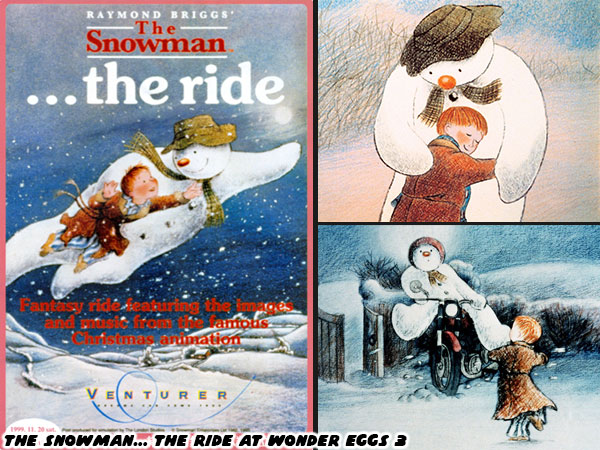
There was also an eight-seater motion ride developed by Hitachi. It was a shooting game called “Contraption!” Each rider was an active participant in a crazy game show. They were “shrunk down” to three-centimeters in size and had to race against the other players to reach the finish line first. Finishers would be returned back to normal size. The employees would say if you don’t make it to the finish line then you’ll remain three-centimeters tall. Ha-ha, very clever! Players could shoot at computer generated targets that popped up on the screen with the use of a trackball controller. From the descriptions I could find it was very difficult. You couldn’t spot your target as you were being bounced around the simulator.
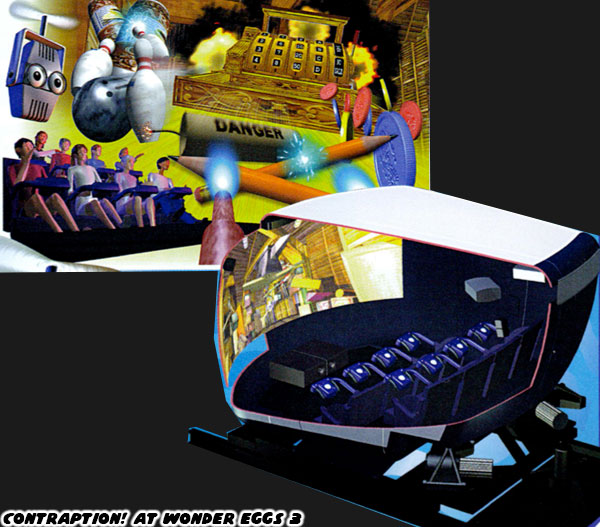
The successes, and failures of different VR, and motion rides helped the theme park industry evolve. Showscan forever altered the course of attractions, and movie development.
Max Flight was still in business, and Hitachi was still in manufacturing. The companies, and their patents would help shape attractions for Universal, Disney, and other park operators over the next 30 years. There was much more to the industry that creating a unique ride. I’ve met people from all over the world that could name a handful of memorable Disney attractions. I couldn’t find many blogs, or articles written about how great the Egg Empire rides were.
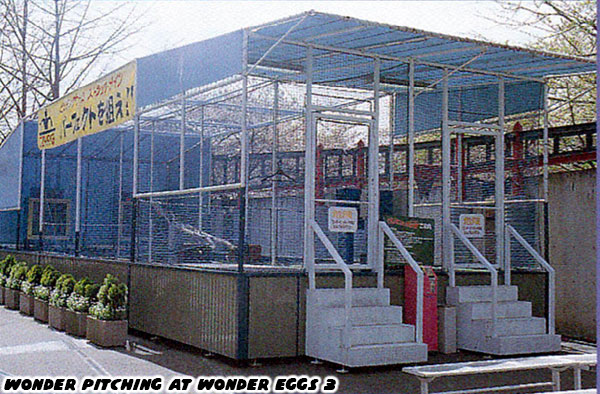
The final days of Wonder Eggs 3 were lackluster. The influx of the motion rides, and attractions like “Wonder Pitching” made the parks feel cheap. Namco managed to preserve some of their reputation. They began expanding their seasonal events. Creating unique shows, collectables, and “rally’s” for Easter, Halloween, and Christmas. To help with overall attendance they built The Bridge of Time and Space. Previously visitors would have to leave each park, cross the road, and buy a separate admission. They changed their policy, and a ticket to one park, allowed you to visit the other. To avoid the crosswalk visitors could take the "Era no Kakehashi" aka the Rainbow Bridge, and remain within the Namco property.

One of the last attractions added to the park was one of the most alarming. It even had more cautions than the other rides in the park; “People using pacemakers are not allowed to use the facility. People living in the city or who are otherwise in poor health are not allowed to use the facility. People under elementary school age must be accompanied by a junior high school student or older (fees apply).” Coffins of Zombie was a spooky two-person ride. The official write up said ““We're going on a "Catacomb Ghost Tour" to test your courage. Can you withstand the series of terrifying experiences that await you?” Riders had to hold onto “sweat sensors” with their hands in order to complete the attraction. Couples were asked to hold hands while riding. The sensors must have sent some sort of electrical current to determine if guests stayed connected. This ride was not for claustrophobic people. Passengers rode standing up in a vertical coffin, as it moved along a track. There were different scenes, and all manner of scary pop up monsters would leap at the guests. The goal was to not let go of each other’s hands until the end. For an extra touch of the macabre there were 13 coffins on the track at any one time.
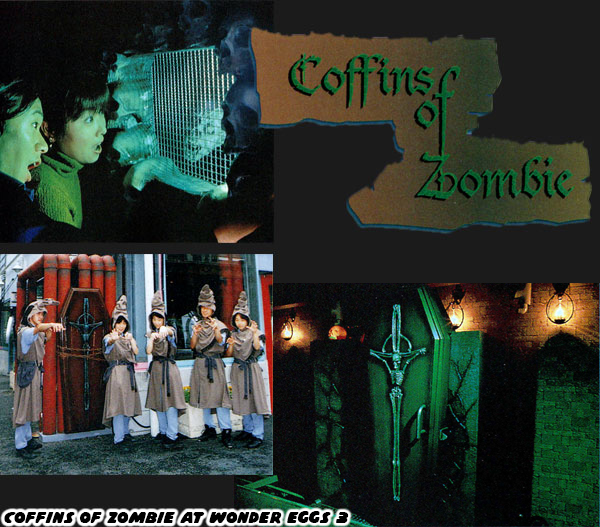
Wonder Eggs certainly went out on a high note. The final year, and especially final few months in operation saw the park reach record attendance. It lasted twice as long as Namco had originally planned, and surpassed 6 million visitors in the process. Despite the stumbles along the way it was a certifiable hit. It would be remembered fondly by people the world over. We will look at that in the next blog. I hope to see you back for that. Were there any defunct parks that you visited? Please tell me about it in the comments section. As always if you would like to sponsor me
please visit my Patreon page and consider donating each month, even as little as $1 would help make better blogs and even podcasts!
Wonder Eggs, and Egg Empire research collected from: Wonder Eggs Guide Map, Namco Graffiti magazine, the book “All About Namco II", NOURS magazine, The Namco Museum, Namco Wiki, Ge-Yume Area 51 Shigeki Toyama Collection, mcSister magazine, first person attraction details from Yoshiki. Event details from Hole in the Socks




















No comments:
Post a Comment